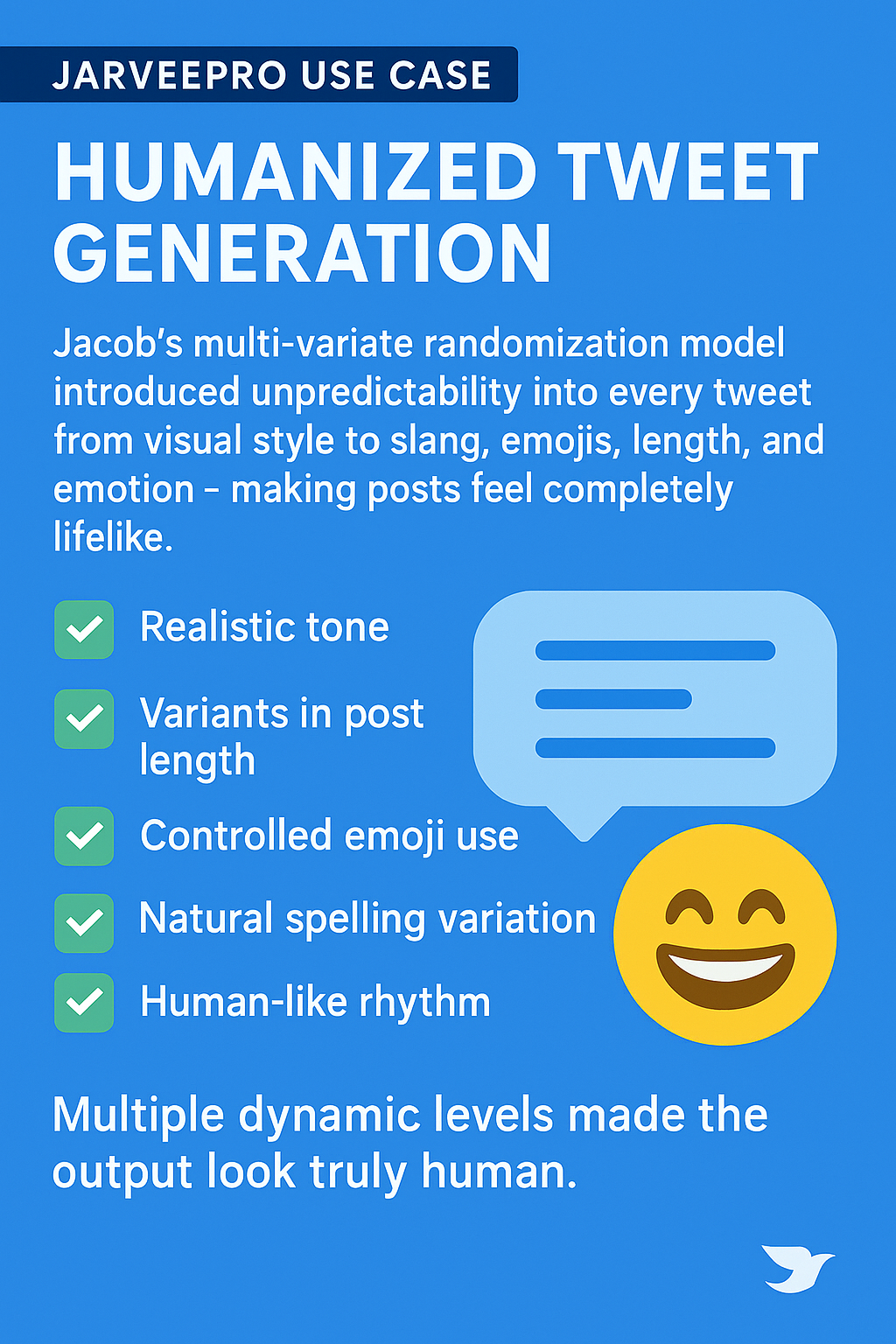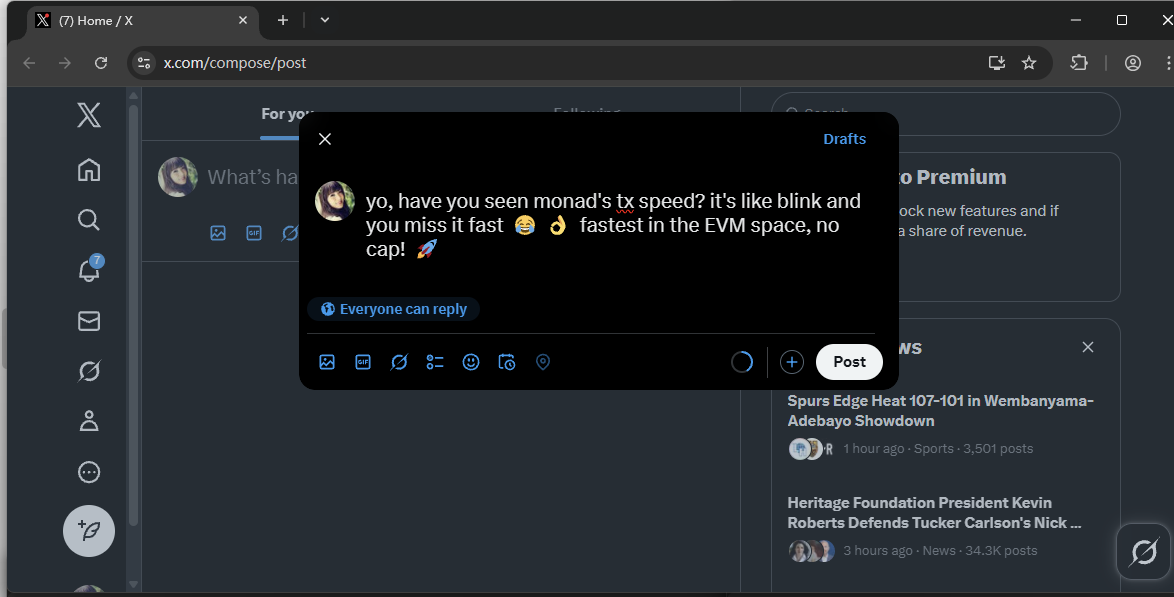How Jacob Uses JarveePro Tweet AI to Achieve 80% Human-Like Twitter Posts
How Jacob Achieved Human-Like Twitter Automation with JarveePro’s Tweet AI
Real use case insights from a power user who understands how to make automation feel truly human.
The Power User Behind the Test: Meet Jacob
Jacob--a hands-on automation strategist who constantly experiments with JarveePro’s advanced Tweet AI. His recent results show that automation can look completely natural, if you understand how to control variables and randomness the right way.
Here’s what Jacob shared from his latest setup and testing:
“Tweet AI is now working perfectly. I fixed the variable issue, and single input character mode is running smoothly. The warmup randomization with percentage chances of likes and retweets works incredibly well.”
The results?
Jacob reports around 80% of his posts escape AI detection—an impressive figure, given how strict Twitter’s anti-AI systems can be.
Understanding the Challenge: AI Detection and Human Simulation
Many creators and marketers face the same problem: AI-generated posts often feel robotic. Platforms like X (Twitter) have advanced detection systems that flag repetitive patterns, overly polished phrasing, or suspicious posting rhythms.
Jacob discovered that topic sensitivity also matters:
“It’s very account and topic based. One subject might trigger stricter detection than another.”
For example, posts about blockchain or financial markets tend to face higher scrutiny than entertainment or meme content. This insight led him to design a smarter randomization framework inside JarveePro.
Building a Truly Humanized Tweet Generation Model
Jacob’s breakthrough came from creating a multi-layer randomization structure—something most users overlook. His Tweet AI setup includes controlled variables for nearly every detail of a post.
Here’s what he randomized:
✅ Chance to include emojis
✅ Chance to change tone or topic angle
✅ Chance to alter post length
✅ Chance to switch between professional or casual tone
✅ Chance to include small typos or informal phrases
✅ Ban on “classic AI symbols” (like too-perfect punctuation or formatting)
Each layer makes the generated text slightly unpredictable, just like a real human typing in the moment.

The Core Prompt: How Tweet AI Thinks Like a Human
Jacob’s prompt for Monad EVM blockchain discussions showcases the sophistication of his approach. His goal: simulate authentic crypto community chatter—short, emotional, and native to the culture.
Style Rules He Used:
Replace long dashes with commas or short dashes
Avoid apostrophes (“dont” instead of “don’t”)
Keep posts under 270 characters
Allow slang, typos, and casual starts when
humanize_level > 0.3Use 50% chance of including relevant emojis
Match tone to one of several vibes: hype, chill, builder-talk, alpha, community, or meme
This system forces AI to write like a real Twitter user—not like a copywriter.
Example of the Logic Behind Each Tweet
His Tweet AI doesn’t just write—it thinks probabilistically before writing.
Here’s the decision tree it follows behind the scenes:
| Step | Randomization Target | Example Output |
|---|---|---|
| 1 | Target length (short/medium/long) | “monad is crazy fast rn 😎 #crypto” |
| 2 | Emoji inclusion (50%) | “building something wild on monad chain 🚀” |
| 3 | Topic angle | “low gas fees and fast txs? monad might actually do it” |
| 4 | Tone (humanize_level) | Conversational, relaxed, no over-polish |
| 5 | Vibe | Builder-talk, hype, or community tone |
| 6 | Trim to 270 chars max | Keeps rhythm and realism intact |
Each post feels alive, unique, and unpredictable — exactly how real users behave online.
Adding Media Randomization
Jacob didn’t stop at text.
He added randomization for media inclusion as well:
Percentage chance to attach a photo, video, or meme
Dynamic mix of hashtags and mentions
Automatic variation in comment length and style
This final layer completed his “All-in Randomization Model” — a near-perfect simulation of organic user behavior powered by JarveePro’s automation engine.
The Takeaway: Automation Done Right Feels Human
Jacob’s use case perfectly demonstrates what separates good automation from great automation.
Instead of repeating patterns or preloaded templates, he used JarveePro’s flexibility to inject randomness, tone variation, and emotional nuance into every post.
His framework can inspire:
Crypto communities trying to grow engagement naturally
Brand marketers aiming for organic interactions
Social media managers balancing volume with authenticity
By embracing structured randomness and AI humanization, Jacob achieved a performance balance—speed, scale, and believability.
Conclusion: JarveePro + Tweet AI = The Future of Realistic Automation
What Jacob built isn’t just a “setup”—it’s a blueprint for the next generation of content automation.
He turned JarveePro into a human simulation engine, where every tweet, like, and retweet feels natural, unscripted, and emotionally resonant.


“We now have randomization on every level — media inclusion, comment length, writing style, emojis, hashtags, topics. All in one call.”
That’s the definition of modern social media automation — realistic, creative, and entirely scalable.
Inspired by Jacob’s workflow?
Explore the possibilities of human-like automation with JarveePro Tweet AI and start building your own authentic engagement system today.


